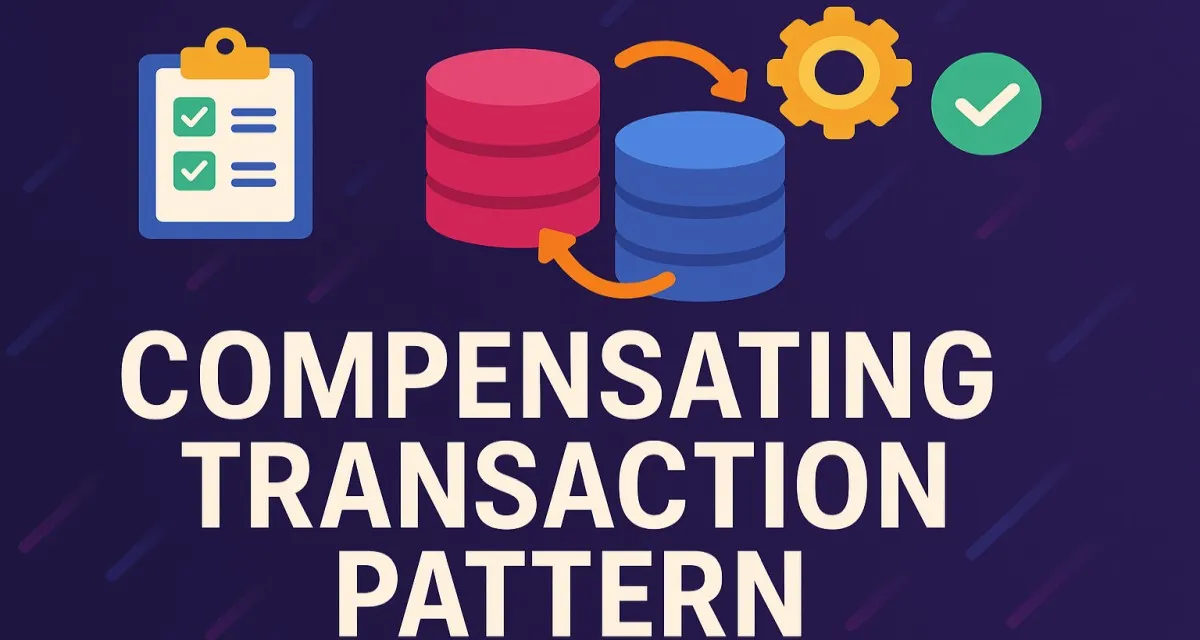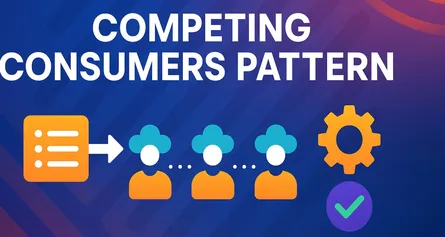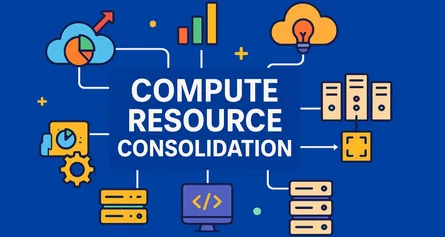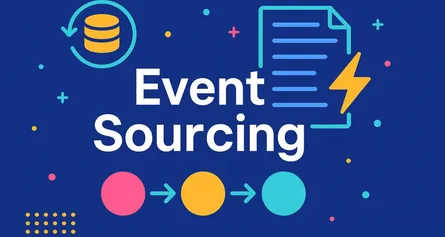
Compensating Transaction Pattern: Ensuring Consistency in Distributed Systems
Imagine you’re building a complex application that manages hotel reservations, flight bookings, and car rentals for customers traveling internationally. Each booking involves separate, independent services distributed across multiple locations and cloud providers. Now, what happens if one service—say, the car rental service—fails after you’ve already booked a hotel and flight? How do you handle the inconsistency this introduces?
Enter the Compensating Transaction Pattern.
This article dives deeply into the compensating transaction pattern, examining why it’s crucial for modern distributed architectures, how it addresses the challenges of distributed transactions, and practical guidelines on implementing it effectively, complete with modern C# code examples.
1. Introduction to the Compensating Transaction Pattern
1.1. Understanding Distributed Transactions and Their Challenges
Distributed transactions are common when dealing with microservices or cloud-native architectures. Unlike traditional, single-database transactions, distributed transactions span multiple services, databases, and networks. These transactions face challenges such as:
- Network Latency: Delays and failures in communication.
- Service Failures: A single failure in one part can impact overall transaction integrity.
- Scalability: Maintaining strict transaction consistency is costly at scale.
- Complexity: Distributed logic is inherently complex, making traditional rollback mechanisms challenging.
So, how can we reliably handle these complexities without sacrificing scalability?
1.2. Definition and Core Concept of Compensating Transactions
Compensating transactions provide a mechanism to reverse or negate previously executed operations in distributed systems, returning the system to a consistent state in the face of failure or inconsistency. Unlike traditional rollbacks, compensations perform logical reversals rather than physical database rollbacks.
Think of it as canceling a hotel reservation instead of trying to erase the booking record entirely—an analogy that simplifies the concept clearly.
1.3. How Compensating Transactions Address Eventual Consistency
In distributed systems, consistency often leans toward eventual consistency rather than immediate. This means that after operations are executed, the system might temporarily exist in a state that is not fully consistent, gradually moving towards consistency.
Compensating transactions help manage this interim state by providing clear pathways to revert or “undo” operations, ultimately reaching consistency even if an error or disruption occurs.
1.4. Relevance in Modern Cloud-Native Architectures
Modern cloud-native applications, particularly those built around microservices, favor eventual consistency and resilience over strict, immediate consistency. Compensating transactions are therefore highly relevant as they provide:
- Fault tolerance: Automatically correcting errors or incomplete states.
- Scalability: Decoupling services and enabling them to manage state independently.
- Flexibility: Facilitating independent deployment and operation of services.
2. Core Principles of Compensating Transactions
Understanding the underlying principles is key to effectively utilizing compensating transactions.
2.1. ACID vs. BASE Principles
Traditional transactions follow the ACID principles:
- Atomicity: Either all operations succeed, or none do.
- Consistency: Transactions bring the database from one valid state to another.
- Isolation: Transactions appear isolated from each other.
- Durability: Committed transactions survive system failures.
In contrast, distributed systems prefer the BASE model:
- Basically Available: System remains operational despite partial failures.
- Soft state: State of the system can change over time, even without input.
- Eventually Consistent: The system guarantees consistency at some point in the future.
Compensating transactions align perfectly with BASE principles, enabling reliable consistency without compromising availability.
2.2. The Role of Compensation in Achieving Business Consistency
Compensation achieves business-level consistency rather than database-level atomicity. It ensures transactions complete or reverse logically rather than physically, preserving the integrity of business operations.
2.3. Idempotency in Compensation Operations
Idempotency means executing the same operation multiple times produces the same state as a single execution. Compensating operations must be idempotent because:
- Failures might require repeated compensation attempts.
- Distributed systems often retry operations automatically.
Here’s a brief example in C# demonstrating idempotency in a compensating operation:
public class PaymentService
{
public async Task CompensatePaymentAsync(Guid paymentId)
{
if (await PaymentAlreadyCompensated(paymentId))
return; // Idempotent guard clause
await ReversePayment(paymentId);
await MarkPaymentCompensated(paymentId);
}
}This code ensures compensation is safely retried without unintended side effects.
3. Key Components of a Compensating Transaction
Compensating transactions consist of clearly defined parts:
3.1. Initial Operations (The “Forward” Path)
These operations execute the intended business logic, such as creating a booking or transferring funds. They establish a baseline state to which compensation can return the system if necessary.
3.2. Compensation Operations (The “Backward” Path)
These operations logically reverse the initial operations. If booking a hotel fails after booking a flight, compensation cancels the flight booking.
Example in C# illustrating compensation logic clearly:
public class BookingService
{
public async Task<bool> BookFlightAndHotelAsync(BookingRequest request)
{
var flightBooking = await flightService.BookAsync(request.FlightDetails);
try
{
await hotelService.BookAsync(request.HotelDetails);
return true;
}
catch
{
await flightService.CancelAsync(flightBooking.Id); // Compensating transaction
return false;
}
}
}3.3. Orchestration and Coordination Mechanisms
Compensating transactions require orchestration. Orchestrators coordinate actions, manage compensations, and handle state transitions.
Common orchestration tools include:
- Azure Durable Functions
- AWS Step Functions
- Custom-built orchestrators
A simple example using Azure Durable Functions:
[FunctionName("OrchestrateBooking")]
public static async Task RunOrchestrator([OrchestrationTrigger] IDurableOrchestrationContext context)
{
var request = context.GetInput<BookingRequest>();
var flightBookingId = await context.CallActivityAsync<Guid>("BookFlight", request.FlightDetails);
try
{
await context.CallActivityAsync("BookHotel", request.HotelDetails);
}
catch
{
await context.CallActivityAsync("CancelFlight", flightBookingId);
}
}3.4. State Management for Transaction Context
State management is essential to keep track of transaction progress and compensation needs. The orchestrator or dedicated state stores, such as Redis or Azure Cosmos DB, typically handle transaction states.
4. When to Apply the Compensating Transaction Pattern
Knowing when to use compensating transactions is crucial for effectiveness.
4.1. Scenarios Involving Distributed Services and Microservices
Whenever you deal with multiple independently-deployed services, compensating transactions ensure business consistency despite failures.
4.2. Long-Running Business Processes
Processes such as supply-chain operations or financial approvals that span days or weeks benefit significantly, enabling flexible error management.
4.3. Handling Failures in Asynchronous Operations
Asynchronous communications, common in distributed architectures, can lead to uncertain states. Compensating transactions provide structured solutions for error handling and recovery.
4.4. Business Cases Where Strict ACID Guarantees Are Not Feasible or Performant
High-volume systems like e-commerce or reservation systems need scalability and responsiveness, making strict ACID compliance impractical. Compensation transactions elegantly balance consistency, scalability, and performance.
5. Implementation Approaches in C# and .NET
When it comes to implementing the Compensating Transaction Pattern, .NET offers several robust options. The right choice depends on your application’s complexity, operational model, and infrastructure.
5.1. Manual Orchestration
Manual orchestration is a straightforward approach suitable for simpler scenarios or when you require direct, low-level control over transaction flow. Here, you coordinate the forward and compensating paths within your own service code, often using standard try-catch logic.
5.1.1. Example: A Simple Multi-Step Operation with Manual Compensation Logic
Imagine an e-commerce checkout process that reserves inventory, processes payment, and generates a shipment order. If payment fails after reserving inventory, you must release that reservation. Manual orchestration lets you implement this compensation logic directly.
Here’s a clear, C#-based example using asynchronous calls and basic compensation handling:
public class CheckoutService
{
private readonly IInventoryService _inventoryService;
private readonly IPaymentService _paymentService;
private readonly IShippingService _shippingService;
public CheckoutService(IInventoryService inventory, IPaymentService payment, IShippingService shipping)
{
_inventoryService = inventory;
_paymentService = payment;
_shippingService = shipping;
}
public async Task<bool> CompleteOrderAsync(OrderRequest request)
{
string inventoryReservationId = null;
try
{
// Step 1: Reserve inventory
inventoryReservationId = await _inventoryService.ReserveAsync(request.Items);
// Step 2: Process payment
var paymentResult = await _paymentService.ProcessAsync(request.PaymentDetails);
if (!paymentResult.Success)
throw new Exception("Payment failed.");
// Step 3: Create shipping order
await _shippingService.CreateOrderAsync(request.ShippingDetails);
return true;
}
catch
{
// Compensation: Release inventory if reserved
if (!string.IsNullOrEmpty(inventoryReservationId))
await _inventoryService.ReleaseReservationAsync(inventoryReservationId);
// Further compensation logic could go here
return false;
}
}
}With this approach, compensation is handled directly in your business logic. While suitable for simple, linear operations, it quickly becomes unwieldy as business processes become more complex.
5.2. Using Workflow Engines and Orchestrators
As business processes grow in complexity—perhaps involving multiple asynchronous or long-running steps—workflow engines become invaluable. They abstract orchestration concerns and provide built-in support for persistence, retries, and compensation.
5.2.1. Introduction to Durable Functions, Azure Logic Apps, and Similar Tools
Azure Durable Functions and Azure Logic Apps are popular orchestrators within the Microsoft ecosystem. Durable Functions, for instance, let you define workflows as code, while Logic Apps offer a low-code, graphical experience.
Both orchestrators allow you to define compensation steps that are triggered automatically on failure. This results in cleaner, more maintainable code and externalizes workflow state management.
5.2.2. Conceptual C# Examples Demonstrating Interaction
Let’s look at a C# implementation using Azure Durable Functions. Suppose you need to orchestrate hotel and flight bookings, with compensating logic in case of failure.
[FunctionName("TravelBookingOrchestrator")]
public static async Task RunOrchestrator(
[OrchestrationTrigger] IDurableOrchestrationContext context)
{
var request = context.GetInput<TravelBookingRequest>();
string flightBookingId = null;
string hotelBookingId = null;
try
{
flightBookingId = await context.CallActivityAsync<string>("BookFlight", request.FlightDetails);
hotelBookingId = await context.CallActivityAsync<string>("BookHotel", request.HotelDetails);
// Both steps succeeded, workflow is complete
}
catch
{
// Compensation steps as needed
if (!string.IsNullOrEmpty(flightBookingId))
await context.CallActivityAsync("CancelFlight", flightBookingId);
if (!string.IsNullOrEmpty(hotelBookingId))
await context.CallActivityAsync("CancelHotel", hotelBookingId);
// Propagate or handle the error
throw;
}
}Each activity (e.g., BookFlight, CancelFlight) is a separate function that can be retried independently. Durable Functions handle state persistence and replay, so your workflow can survive restarts, scaling events, and even downtime.
With Azure Logic Apps, you can achieve similar results through visual workflows, calling out to C# APIs for specific steps, and defining compensation actions as part of the workflow logic.
When do you reach for orchestrators? Typically when you have:
- Long-running or asynchronous business processes
- Multiple failure points with associated compensation logic
- The need for visual monitoring, retries, and state tracking
5.3. Leveraging Event-Driven Architectures
In many distributed systems, services interact via events instead of direct calls. Event-driven architectures embrace loose coupling, allowing services to react to business events and initiate compensation when something goes wrong.
5.3.1. Publishing “Transaction Started” and “Transaction Failed” Events
The core idea is that each service publishes events to a message broker (e.g., Azure Service Bus, RabbitMQ, or Kafka) as operations progress.
For example, after a user submits an order, your service might publish an OrderPlaced event. Downstream services (like Inventory, Payment, Shipping) subscribe to this event and act accordingly. If a service fails, it emits an OrderFailed event that triggers compensation workflows elsewhere.
Here’s a basic C# example of publishing a transaction event:
public async Task PublishEventAsync<T>(T @event)
{
var json = JsonSerializer.Serialize(@event);
var message = new ServiceBusMessage(json);
await _serviceBusSender.SendMessageAsync(message);
}And the events might look like:
public record OrderPlaced(Guid OrderId, List<Item> Items);
public record OrderFailed(Guid OrderId, string Reason);5.3.2. Subscribing to Events for Compensation
Compensating logic is implemented by subscribers that listen for failure events. Suppose the Inventory service receives an OrderFailed event, it will then release any previously reserved stock.
Here’s how you might subscribe and handle compensation in C#:
public class InventoryCompensationHandler
{
public async Task HandleOrderFailedAsync(OrderFailed orderFailed)
{
await _inventoryService.ReleaseReservationAsync(orderFailed.OrderId);
// Other compensating actions if needed
}
}In a production scenario, this handler would be wired to an event listener on your message broker. You’d ensure all compensation handlers are idempotent and capable of safely retrying in the event of delivery failures or duplicates.
Event-driven approaches excel when:
- You’re dealing with highly decoupled services
- Business processes span multiple domains or teams
- You need to scale compensation logic independently
6. Advanced Implementation Techniques (C# and .NET Specific)
As distributed systems grow, so does the sophistication required for their compensating transaction logic. Recent advances in the .NET ecosystem, especially with .NET 8 and C# 12, provide powerful constructs to streamline and enhance these implementations.
6.1. Leveraging .NET 8+ Features
Modern .NET releases introduce language and framework features that are especially useful for building distributed, resilient workflows.
6.1.1. Asynchronous Streams for Orchestrating Long-Running Operations
Long-running workflows often benefit from incremental progress reporting, dynamic branching, or the ability to “pause and resume.” C#‘s asynchronous streams (IAsyncEnumerable<T>) allow you to represent workflows as a sequence of steps or events, yielding control at each stage.
Consider a scenario where each step of a business process is emitted as a stream event. You can compensate if something fails, with each stage aware of its own context:
public async IAsyncEnumerable<string> ProcessOrderAsync(OrderRequest order, [EnumeratorCancellation] CancellationToken ct = default)
{
var inventoryReservation = await _inventoryService.ReserveAsync(order.Items);
yield return "Inventory reserved";
var paymentResult = await _paymentService.ProcessAsync(order.PaymentDetails);
if (!paymentResult.Success)
{
await _inventoryService.ReleaseReservationAsync(inventoryReservation);
yield return "Payment failed, inventory released";
yield break;
}
yield return "Payment processed";
var shipmentId = await _shippingService.CreateOrderAsync(order.ShippingDetails);
yield return "Shipping order created";
}This approach offers fine-grained control, simplifies progress reporting, and is naturally testable.
6.1.2. Pattern Matching for Handling Different Compensation Scenarios
Complex compensation logic often requires branching based on specific failure types or transaction outcomes. With modern C# pattern matching, your code becomes more readable and concise.
For example:
public async Task CompensateAsync(TransactionFailure failure)
{
switch (failure)
{
case PaymentFailure pf:
await _paymentService.RefundAsync(pf.PaymentId);
break;
case InventoryFailure inf:
await _inventoryService.ReleaseReservationAsync(inf.ReservationId);
break;
case ShippingFailure sf:
await _shippingService.CancelOrderAsync(sf.ShipmentId);
break;
default:
throw new NotSupportedException($"Unknown failure type: {failure.GetType().Name}");
}
}Using pattern matching, you centralize compensation logic and make future extensions (new failure types) straightforward.
6.1.3. Source Generators for Generating Boilerplate Compensation Code (Conceptual)
Large-scale systems may require many similar compensation handlers, leading to repetitive code. Source generators, introduced in recent .NET, allow you to generate this boilerplate at compile time.
For instance, imagine annotating your operations:
[GenerateCompensationHandler]
public class PaymentOperation
{
public Task ExecuteAsync(PaymentRequest request) { /* ... */ }
public Task CompensateAsync(PaymentRequest request) { /* ... */ }
}A custom source generator could then automatically create dispatcher classes that wire up compensation calls, reducing manual errors and maintenance overhead. While this is an advanced, conceptual pattern, it’s increasingly viable in large projects where consistency and speed matter.
6.2. Error Handling and Retries
Robust error handling is essential. Distributed transactions inevitably encounter transient failures. How do you avoid overreacting to brief outages while also protecting your system from cascading errors?
6.2.1. Implementing Exponential Backoff and Circuit Breaker Patterns with Polly
Polly is a widely used .NET resilience library. It helps you implement sophisticated retry, backoff, and circuit breaker strategies with minimal code.
For instance, suppose you want to retry compensation with exponential backoff, but stop retrying if the service seems unhealthy:
var retryPolicy = Policy
.Handle<TransientException>()
.WaitAndRetryAsync(
retryCount: 5,
sleepDurationProvider: attempt => TimeSpan.FromSeconds(Math.Pow(2, attempt))
);
var circuitBreakerPolicy = Policy
.Handle<Exception>()
.CircuitBreakerAsync(
exceptionsAllowedBeforeBreaking: 3,
durationOfBreak: TimeSpan.FromMinutes(1)
);
// Composing policies
var resilientPolicy = Policy.WrapAsync(retryPolicy, circuitBreakerPolicy);
await resilientPolicy.ExecuteAsync(() => _inventoryService.ReleaseReservationAsync(reservationId));This approach lets you absorb transient failures without overwhelming dependent systems, while protecting yourself from repeated or systemic faults.
6.2.2. Strategies for Dealing with Partial Failures
Partial failures—when some operations succeed and others don’t—are a fundamental reality in distributed systems. Good compensation design means thinking carefully about which steps can be independently reversed, and which require coordination.
Typical strategies include:
- Best-effort compensation: Attempt to undo what you can, and log failures for manual follow-up if needed.
- Compensation chaining: Compensate in the reverse order of execution, rolling back as far as possible.
- Escalation policies: If automated compensation fails, notify operations teams or raise business events for manual resolution.
You might encapsulate these strategies:
public async Task CompensateWithChainingAsync(List<ICompensationStep> steps)
{
foreach (var step in steps.AsEnumerable().Reverse())
{
try
{
await step.CompensateAsync();
}
catch (Exception ex)
{
// Log and continue to next step; escalate if necessary
await _logger.LogErrorAsync($"Compensation failed: {ex.Message}");
}
}
}6.3. Persistence and Idempotency
Maintaining state and ensuring compensation steps are idempotent is non-negotiable. Retries and message duplication are routine in distributed systems.
6.3.1. Ensuring Compensation Operations Are Idempotent
Idempotency ensures repeated execution of a compensation step has the same effect as a single execution. This can be enforced at the data and code level.
For example, use a database flag or token:
public async Task CompensatePaymentAsync(Guid paymentId)
{
var payment = await _dbContext.Payments.FindAsync(paymentId);
if (payment.Compensated)
return; // Already compensated, exit
await _paymentGateway.RefundAsync(payment.Reference);
payment.Compensated = true;
await _dbContext.SaveChangesAsync();
}By checking state before acting, you ensure safety even under duplicate or retried messages.
6.3.2. Storing Transaction State (e.g., in a Database, Distributed Cache)
Storing transaction and compensation state is critical for recovery, monitoring, and future-proofing your system. Options include:
- Relational Databases: Ideal for strong consistency and auditing.
- NoSQL Databases: (e.g., Cosmos DB, MongoDB) Scale well for large, high-throughput operations.
- Distributed Caches: (e.g., Redis) Fast, ephemeral storage for short-lived transaction states.
Sample model for transaction state:
public class TransactionState
{
public Guid TransactionId { get; set; }
public TransactionStatus Status { get; set; }
public DateTime LastUpdated { get; set; }
public List<CompensationStep> Steps { get; set; }
}Persisting this data allows you to:
- Safely retry compensation after process crashes or restarts
- Support manual intervention if automated compensation fails
- Monitor transaction health and performance over time
7. Real-World Use Cases and Architectural Scenarios
Let’s move beyond theory and examine how the Compensating Transaction Pattern comes alive in real-world systems. Seeing practical examples clarifies when and why this pattern matters.
7.1. E-commerce Order Processing
Imagine an online retailer processing thousands of orders daily, each involving payment processing, inventory management, and logistics. Traditional ACID transactions don’t scale well here, especially across distributed microservices.
Instead, the Compensating Transaction Pattern ensures reliability without sacrificing scalability. For instance:
-
Reserve Inventory → Process Payment → Create Shipment
- If payment processing fails, a compensating transaction releases reserved inventory.
- If the shipping service fails, compensation refunds the payment and releases inventory.
7.2. SaaS Application Provisioning
Software-as-a-Service (SaaS) providers commonly provision resources dynamically. This might involve:
- Create Tenant Database → Configure Identity Management → Provision Compute Resources
Each step might involve independent services or cloud resources. If a step fails, you need clean, reliable compensating logic to revert partially provisioned resources.
For instance, if identity management fails:
- The compensating transaction deletes the tenant’s database.
- Resources are reclaimed cleanly, preventing leaks or orphaned resources.
7.3. Financial Transaction Systems (Non-ACID Critical Paths)
While banking systems traditionally rely heavily on ACID, modern financial systems—especially digital wallets and fintech platforms—often prefer eventual consistency for scalability.
Consider transferring funds between accounts in a mobile wallet scenario:
- Debit Account A → Credit Account B
- If crediting account B fails after debiting A, a compensation transaction restores funds to account A.
This approach provides business-level consistency without demanding strict database-level atomicity—vital in scalable fintech services.
7.4. Integrating with Third-Party APIs
Third-party APIs frequently present uncertainty. You can’t always guarantee their uptime or transactional reliability. Compensating transactions let your application gracefully handle third-party failures.
For example, integrating a payment gateway:
- Your system marks a payment as pending.
- You invoke the third-party API. If the call fails or times out, compensation marks the payment attempt as canceled internally.
This ensures your system remains consistent, irrespective of external uncertainties.
8. Common Anti-patterns and Pitfalls
While powerful, the Compensating Transaction Pattern is not without potential pitfalls. Here’s how to avoid common mistakes.
8.1. Over-compensating or Under-compensating
Over-compensation means undoing more than required, losing legitimate user data or state. Under-compensation leaves the system in an inconsistent state.
Solution: Precisely match compensations to the original operations, testing rigorously to confirm boundaries.
8.2. Ignoring Idempotency in Compensation
Non-idempotent compensation is a ticking time bomb. Multiple compensations can trigger unintended side-effects.
Solution: Design all compensation operations explicitly to be idempotent, using unique transaction identifiers.
8.3. Complex Compensation Chains (Managing Dependencies)
Complex compensation chains (multiple dependencies across distributed services) are error-prone and difficult to debug.
Solution: Keep compensation chains simple and independent. Consider orchestrators or event-driven patterns for better manageability.
8.4. Lack of Observability into Transaction State
Not tracking state clearly leads to “black box” scenarios, frustrating troubleshooting.
Solution: Implement comprehensive logging, tracing, and monitoring of transaction states and compensation outcomes.
8.5. Misunderstanding Eventual Consistency
Eventual consistency doesn’t mean “maybe consistent.” Misunderstanding this leads to inadequate compensation logic or unrealistic expectations.
Solution: Educate stakeholders clearly on what eventual consistency implies and implement compensating logic accordingly.
9. Advantages and Benefits
Why adopt the Compensating Transaction Pattern? Let’s summarize clearly:
9.1. Enabling Loosely Coupled Systems
Compensation promotes independent, autonomous services, simplifying deployments and updates. Changes to one service rarely break others, facilitating agile development.
9.2. Improving Scalability and Resilience in Distributed Environments
With compensation, your architecture can scale horizontally without strict transaction locking, significantly improving performance and availability.
9.3. Handling Failures Gracefully in Long-Running Processes
Long-running workflows are inherently failure-prone. Compensating transactions provide structured recovery pathways, maintaining business continuity despite errors.
9.4. Achieving Business Consistency Where ACID Isn’t Practical
Some scenarios simply can’t guarantee ACID transactions due to performance or distributed limitations. Compensation provides a pragmatic alternative ensuring business-level correctness.
10. Disadvantages and Limitations
While beneficial, compensating transactions aren’t universally suitable. Here’s a balanced view of limitations:
10.1. Increased Complexity in Design and Implementation
Proper compensation logic is inherently complex, requiring careful design, thoughtful orchestration, and thorough testing.
10.2. Challenges with Debugging and Monitoring Distributed Transactions
Distributed compensation can be difficult to monitor and debug, especially if state tracking isn’t comprehensive or structured clearly.
10.3. Potential for Data Inconsistencies During Compensation
Compensation isn’t instantaneous. Temporary inconsistencies can arise during rollback phases, potentially affecting downstream business logic or analytics.
10.4. Not Suitable for All Scenarios (Where Strong ACID Is Mandatory)
Critical financial or medical scenarios requiring instantaneous consistency cannot tolerate even temporary inconsistencies, making compensation inappropriate.
11. Conclusion and Best Practices
The Compensating Transaction Pattern provides essential tools for modern distributed architectures, allowing businesses to navigate distributed complexity gracefully.
11.1. Summary of Key Takeaways
- Compensation is crucial for distributed and event-driven systems, balancing consistency with performance.
- Design your compensation logic explicitly, clearly, and with idempotency at the forefront.
- Monitor and log comprehensively to ensure maintainability and troubleshooting efficiency.
11.2. Guidance on When and How to Effectively Apply the Pattern
Apply the pattern in scenarios involving microservices, long-running workflows, distributed transactions, or integration with external APIs. Evaluate carefully whether eventual consistency meets your business requirements.
11.3. Considerations for Monitoring, Testing, and Maintainability
- Monitoring: Use distributed tracing (OpenTelemetry), structured logging, and real-time dashboards.
- Testing: Emphasize automated integration and scenario tests covering compensation logic.
- Maintainability: Keep compensations modular, well-documented, and simple to adapt as business needs evolve.
11.4. Future Trends and Evolution of Distributed Transaction Patterns
Looking forward, distributed transaction management will increasingly rely on smarter orchestrators, AI-driven observability, and code generation frameworks. Expect continuous refinement of compensation logic automation and more robust tooling in frameworks such as .NET, Azure, and other cloud platforms.
Share this article
Help others discover this content
About Sudhir mangla
Content creator and writer passionate about sharing knowledge and insights.
View all articles by Sudhir mangla →




